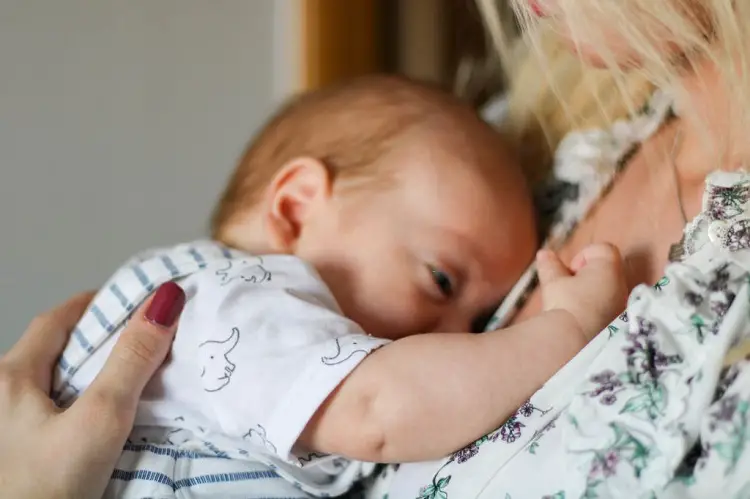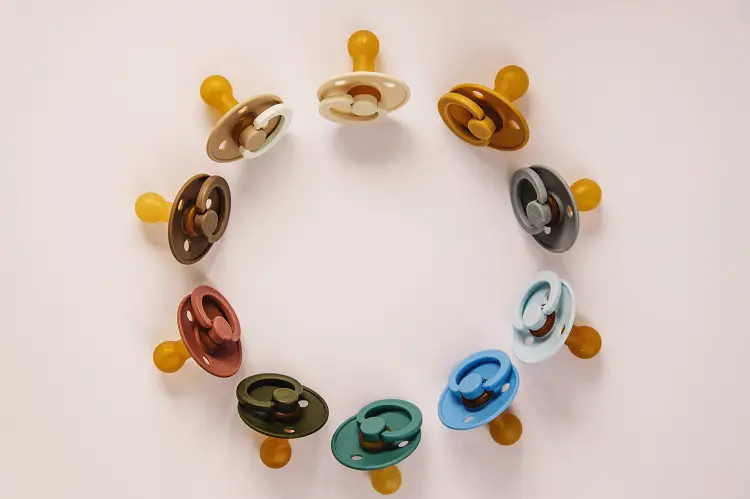Have you ever pondered on introducing pacifiers to your breastfed baby? As a mother, you might be scared that introducing pacifiers might cause nipple confusion in your baby.
You might have heard the question can breastfeeding babies use pacifiers probably from a concerned mother which maybe you or someone else.
Do you feel guilty at the thought of introducing a pacifier to your breastfed baby that you want to know if breastfed babies can use pacifiers?
Read on as we answer your question of can breastfed babies use pacifiers, why you should use them, its disadvantages, and the 3 best pacifiers for breastfed babies.
Why Use Pacifiers
Pacifiers are recommended for some parents because it helps the babies in self-soothing and then helps the nursing mothers have some breathing space.
Pacifiers work magic with children because an angry, screaming baby can become a calm, sweet angel when given pacifiers.
Motherhood is extremely demanding and tasking that sometimes mothers usually forget themselves while caring for their babies.
Using a pacifier can help keep the baby calm while the mother undergoes mental and physical breaks without nursing the fear of your baby being uncomfortable.
Can Breastfed Babies Use Pacifiers?

The answer is YES. Breastfed babies can use pacifiers and when introduced correctly the effect is magical and benefits tremendously. According to the AAP, it’s best advised to start using a pacifier after breastfeeding is well established.
As a nursing mother, you can harness the beauty laden in the use of pacifiers without feeling guilty about it. According to research, the use of pacifiers can help reduce the burden of sudden infant death syndrome drastically.
During venipuncture, a pacifier can play a huge role as it helps to reduce infants’ crying during such procedures that cause pains to the baby. Some parents and caregivers also like using a pacifier for a baby who loves to suck their thumb or fingers.
It has been reported anecdotally that the use of pacifier among stimulant users can help in reducing bruxism and thus prevents tooth damage. It is also known to help infants to get to sleep and also keep infants calm.
Using a pacifier on breastfed babies teaches them how to self-soothe, helping them to stay calm while the mother gets some time for herself because momentarily she doesn’t have to worry about her baby.
When Is The Right Time To Introduce Pacifier To A Breastfed Baby?
There is time for everything and proper timing is needed when introducing pacifiers to a breastfed baby. You should not introduce a pacifier to your baby until he or she is about a month old.
Disadvantages of Pacifiers for Breastfed Babies
There are two sides to a coin and it simply means that to everything with an advantage, at some point there may be some disadvantages.
Some of the things you should be conversant with before introducing pacifiers to your baby are:
- Research has proven that babies who were introduced to pacifiers wean from the breast earlier than babies that were not introduced to it, because the sucking of their pacifiers satisfies the sucking urge in babies hence they lose interest easily in sucking the breast.
- If a pacifier is used to replace nursing time, your milk supply may be affected which could lead to weight loss in your baby.
- Babies who use pacifiers are at risk of developing an oral yeast overgrowth called thrush.
- Chances of ear infections tend to be higher in babies who use pacifiers. This is why the AAP recommends you limit the use of it by your baby after 6 months of age.
- Pacifiers often fall out of newborn mouths usually when they’re asleep which exposes them to all sorts of germs, especially if they are not frequently cleaned and sanitized.
- Pacifiers that are not in good condition are hazardous for your baby and may cause a choking sensation, so endeavor to inspect your baby’s pacifier before usage.
- Excessive use of pacifiers also leads to dental problems so make sure that your baby stops using pacifiers once he or she clocks 2 years of age.
- Your baby can become too attached to his/her pacifiers making it difficult for him to stop using the pacifier when the time comes.
- Excessive use of a pacifier during the day could prevent your baby from getting enough milk at daytime feedings, and this could be the reason why your baby wakes more often during the night to eat.
Read Also: Newborn Night Feeding Tips For First Time Moms
What Kind of Pacifier Works Best for a Breastfed Baby?

There are different brands of pacifiers in the market and eventually, not all of them are suitable for a breastfed baby
For a breastfed baby, do not give your baby a pacifier with bulbs at the end, as this type of pacifier may turn them into a lazy sucker whose breastfeeding session may become hectic
If you are choosing pacifiers for your baby, try choosing one that closely resembles the mom’s nipple. Make sure that your choice of a pacifier has a rounded tip, is made up of silicone, and has a skin-feeling-like material choose a pacifier that isn’t too large.
The 3 Best Pacifiers For Breastfed Babies
1. The First Years Gumdrop Newborn Pacifiers
- Specifically made for babies up to 3 months and comes in large sizes for older toddlers
- One-piece design
- BPA-free, medical-grade silicone
- Generally used in hospitals worldwide
- Has bright colors
- The shield has a shape that looks like a heart, which won’t block your baby’s nose and gives them a comfortable space to breathe freely while sucking
- Its shape curves to your baby’s face, hence increasing the stability
- The pacifier is available in bulk, you get it in any store or online in 5-packs so there’s also an extra for you.
- Affordable
Cons
- Some parents complain that their babies’ fingers usually get stuck in the holes
- Limited use
2. Philips Avent Soothie Pacifier
- It comes in different sizes to grow with your baby
- Very affordable
- Recommended for newborns because the base is wide so your baby won’t suck the whole pacifier in his mouth and choke
- It is generally used in hospitals nationwide in the U.S
- Comes in pretty colors
- It is BPA free, latex-free, hospital-grade silicone
- One-piece construction
Cons
- Some parents complained that their baby rejected it due to the shape and rigidity
- Some parents had issues with their babies’ fingers getting stuck in the holes
- Other users say that the Soothie falls out of baby’s mouth easily
- Its shield is large for the pacifier
- Limited use
3. Ryan & Rose Cutie-PAT pacifier
- It is a 2 in 1 pacifier and can also function as a teether
- It is 100% medical-grade, BPA-free silicone
- Has one-piece design
- It comes in all kinds of colors
- You can attach it easily to a pacifier clip of your choice
- Its material is soft
- Designed with breathing holes for easy airflow
Cons
- The way the writing on the pacifier faces and sticks out to the baby could make babies reject it
- Some parents complained that this pacifier is too soft and is not as strong as other brands
- It is quite expensive than other pacifiers and only comes with one
Final Verdict:
Our top choice for the Best Pacifier for Breastfed Babies is the First Years Gumdrop Newborn Pacifier, this is because it’s affordable, has an outstanding design, and can be very easy to wipe clean, grip, and you can make use of generic pacifier clips with it.
Read Also: How Many Pacifiers Do I Need For My Baby?
Other Pacifier-Related Questions
Does Using Pacifiers Affect Baby’s Breastfeeding Session?
One of the genuine fears why a mother may be hesitant to introduce pacifiers is nipple confusion, but do remember that introducing your baby to a pacifier wouldn’t make breastfeeding impossible.
A 2016 study that focused on more than 1,300 babies concluded that pacifier use had no impact on whether an infant is still breastfeeding by 3 or 4 months.
Pacifiers usually have calming effects on babies because naturally babies are born with built-in sucking reflexes which is why pacifiers can be so calming.
According to the American Academy of Pediatrics, It’s best to start using a pacifier after breastfeeding is well established.
What Time of Day Should I Allow My Baby Use a Pacifier?
Do not give your baby a pacifier before breastfeeding make sure that the pacifier is handed over to your baby after breastfeeding.
Sometimes giving pacifiers to your baby only at night may be an ideal way of limiting your baby’s use of pacifiers and make sure you put away the pacifier once they fall off your baby’s mouth.
Sometimes introducing pacifiers to your baby who is still breastfeeding may be difficult, but it is not impossible. Just ensure that you carefully choose when to introduce pacifiers as well as what times of the day you offer them to your baby.
Read Also: Pacifier Alternatives For Babies and Toddlers
When To Stop Using Pacifiers
There are times and circumstances when pacifier usage is a no for your baby.
- Do not use pacifiers in place of feeding when you suspect hunger
- When your baby is having issues with breastfeeding or with weight gain
- When your baby is suffering from an ear infection
- When your baby has thrush
Other Safety Tips To Keep In Mind
- Avoid using pacifiers that are two pieces, it is recommended to go for ones that are one continuous piece. Two-piece pacifiers can cause a choking hazard to your baby when they separate.
- Ensure you clean your baby’s pacifiers every day to prevent thrush and bacterial infections. Always follow the manufacturer’s manual guide for proper use and care. You can clean some pacifiers using a dishwasher, while others should be cleaned using warm, soapy water and rinsed well.
- Avoid hanging a pacifier around your baby’s neck or use any kind of string or item to tie the pacifier to your baby’s crib, car seat, or stroller. Doing this could cause a strangulation hazard.
- Never use the nipple from a bottle as a pacifier. This is not safe for your baby and may cause the baby to choke.
- Many pacifier manufacturers often include the size of the pacifier for the age of the baby. Always use the right size for your baby. An older baby could choke on a newborn pacifier since the entire pacifier can fit into his/her mouth.
- Avoid using latex pacifiers if you are worried about the possibility of latex allergies.
- Always check your baby pacifiers for any signs of wear and breakdown. You should have them replaced when they become discolored, broken, or damaged.
Related Posts:
- How To Get Baby To Sleep Without Pacifier
- Does Wubbanub Help Keep Pacifier in Baby Mouth
- How To Sterilize Pacifiers
Conclusion
We hope this article has given in-depth discussion to answer your question of can breastfed babies use pacifiers along with other pacifier-related questions that come to mind.
The ball is your court you can use pacifiers for your breastfed baby or you can decide otherwise, the decision is yours to make. Do what’s best for you and your baby; you’re the only one to determine whether the use of a pacifier will benefit you both.
However, if you decide to introduce a pacifier to a breastfed baby, it’s best advised you wait until the breastfeeding session is well established, which usually happens when babies are 1 month old.
If you’re worried or unsure about anything, do not hesitate to consult your baby doctor or any licensed lactation consultant.
